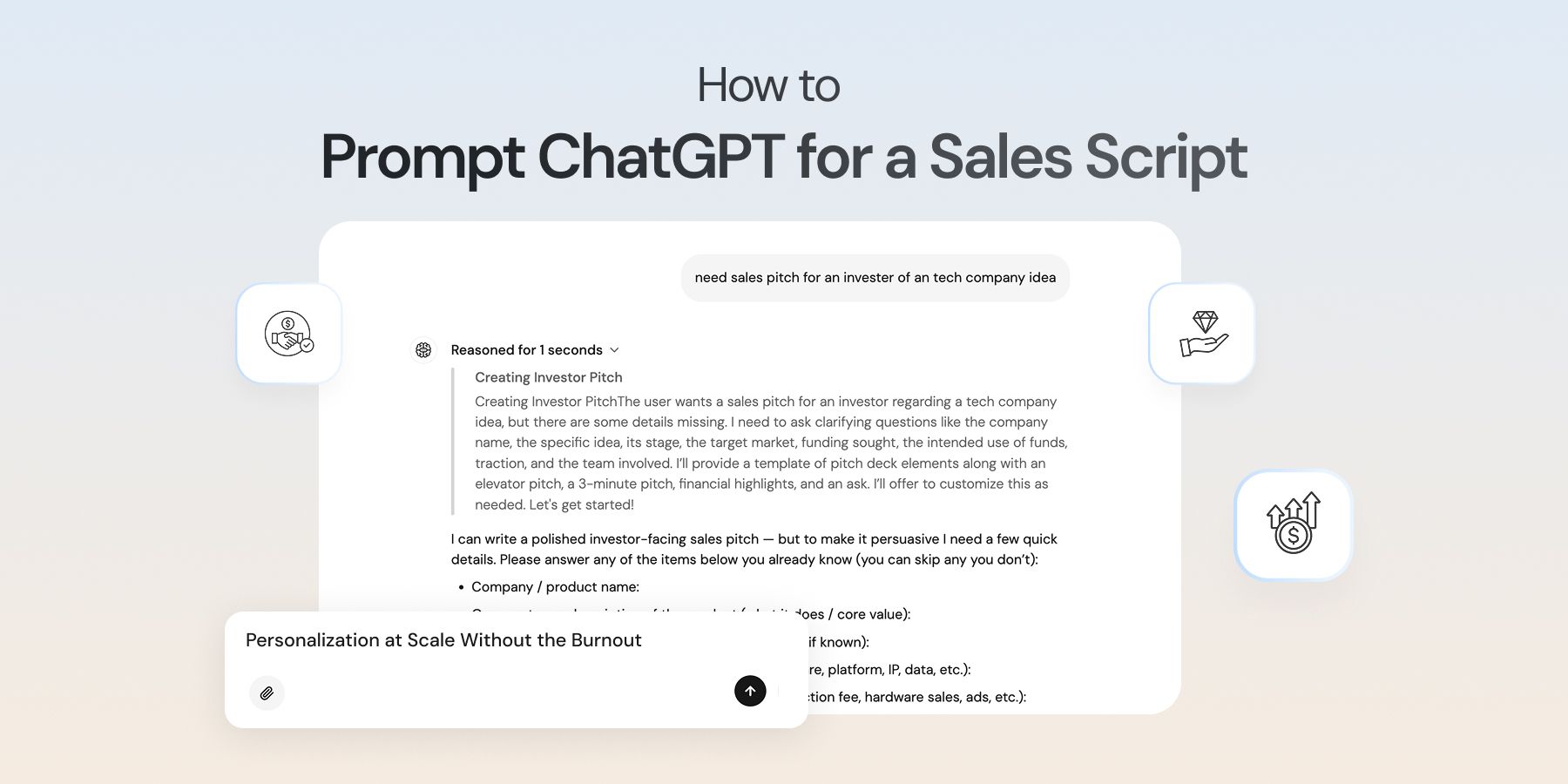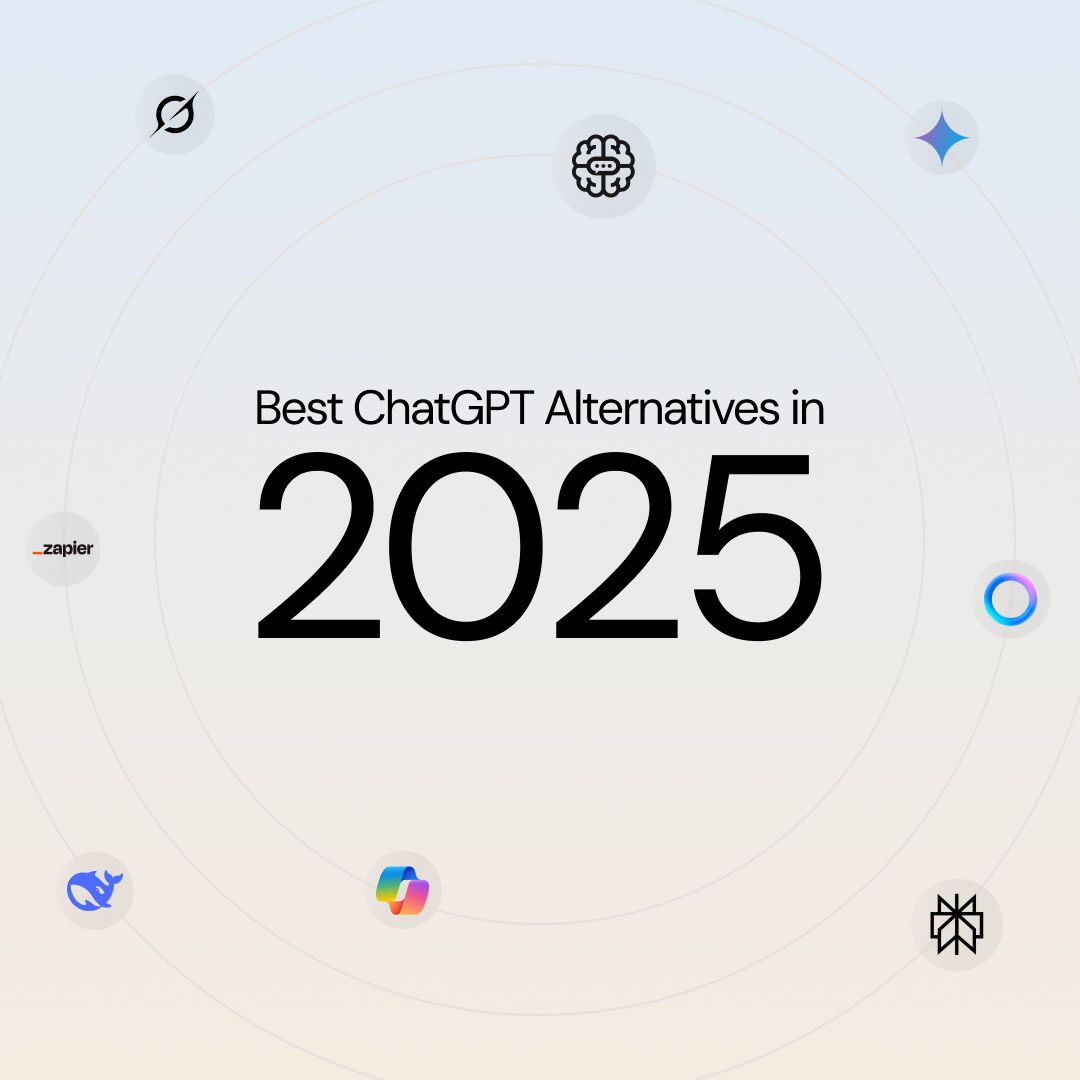
How to Prompt ChatGPT for a Sales Script
Sales prospecting eats more time than it should. Cold emails, LinkedIn openers, call scripts, follow-up sequences — every rep knows the grind. Hours vanish before a single meaningful conversation even starts, and the mental fatigue shows in every recycled line.
ChatGPT for sales gives a way out. You give it direction, and it builds drafts that would normally take hours. But here’s the truth most people miss: prompts matter. If you feed vague instructions, you get robotic garbage. If you use sharp prompts, you get scripts that can actually win attention.
But if you are also looking for ChatGPT alternatives, you might as well explore a few options.
This guide is not theory or filler. It is a playbook on using ChatGPT for sales prospecting, with prompts you can lift, adjust, and use today.
Here's what you can find in this blog.
-
Why using ChatGPT for sales prospecting works at scale
-
The structure of effective ChatGPT sales prompts that drive results
-
Prompt templates for cold email, LinkedIn, calls, and follow-ups
-
Using ChatGPT for sales research on accounts, industries, and personas
-
Advanced techniques like role-play, A/B testing, and building prompt libraries
-
The limits of ChatGPT for sales and when to edit manually
Why Use ChatGPT for Sales Prospecting?
Prospecting is the toughest and most exhausting part of sales. It demands a balance of volume, speed, and personalization, and most reps crack under that pressure. ChatGPT fills the gap by giving speed without losing the quality or tone that prospects demand.
Save Hours on Outreach Without Sacrificing Quality
Every sales rep has wasted hours writing cold emails line by line. Using ChatGPT for sales means generating multiple drafts within minutes, testing subject lines faster, and moving forward without that heavy creative drag. You still choose the best version, but the time saved compounds quickly.
Personalization at Scale Without the Burnout
Prospects ignore copy-paste templates. They want proof you know their role, their company, or the problem they are facing right now. ChatGPT for sales prospecting allows you to drop in details like a company name, a recent funding announcement, or even a new hire. It transforms those details into sharp messages that sound researched and targeted.
Consistency Across Teams and Channels
Sales teams rarely sound the same across every rep. Some lean too casual, others sound corporate, and the brand tone suffers. ChatGPT sales prompts provide a baseline that keeps outreach consistent across emails, LinkedIn messages, call scripts, and even follow-ups. Consistency builds trust, and trust builds responses.
Sales Scripts for Every Prospecting Channel
Cold emails are only the first touch. Reps also need voicemail introductions, discovery call questions, objection handling lines, and nurturing follow-ups. Chat gpt prompts for sales can cover every single channel, turning one tool into the backbone of your outbound efforts.
Scale Prospecting Without Running Out of Ideas
After fifty messages, creativity dries up. The copy turns dull, and prospects can smell recycled lines instantly. Using ChatGPT sales prompts ensures you always have fresh angles, new hooks, and stronger subject lines ready to test, no matter how much volume you push.
The Anatomy of a Good ChatGPT Sales Prompt
ChatGPT does not magically create strong sales scripts by itself, it only builds what you ask it to build. The difference between a weak prompt and a strong one is not small, it decides whether your script sounds like spam or actually gets a reply.
A good prompt always carries four things inside it: role, context, goal, and tone. If one of these elements is missing, the output often falls flat and needs more rewriting than it should.
-
Role tells ChatGPT who it should act as, such as a sales rep, a cold outreach specialist, or even a coach training a team of SDRs.
-
Context gives the information about the product, the audience, or the scenario you want to simulate. Without context, the script will always sound generic, and nobody replies to generic.
-
Goal states clearly what you want from the message, like getting a reply, booking a demo, or opening a door for a later conversation.
-
Tone controls how it sounds. Too formal can feel stiff, too casual can feel unserious. The right tone lands somewhere in the middle, and the prompt should guide the output toward that line.
Here is an example of a weak prompt: “Write a cold email for my software.” That will give you something robotic and forgettable.
Here is an example of a strong prompt:
“You are a sales rep reaching out to a VP of Marketing at a mid-size SaaS company. Write a cold email that highlights how our analytics platform reduces churn and helps identify upsell opportunities. Keep it under 120 words, professional yet approachable.”
The second one is specific, structured, and aligned with the role, context, goal, and tone. You can see instantly how much more usable the output becomes, with less cleanup required.
Building a System Around Your Prompts
One good script is useful, but sales is not about one script, it is about running the same process every day at scale. That means you need a repeatable system for using ChatGPT sales prompts that works inside your workflow.
The easiest way is to start with a library of core prompts. These are prompts you can use for cold email outreach, LinkedIn prospecting, discovery calls, objection handling, and follow-ups. Each rep can take the same library and personalize it based on their accounts. Over time, you refine the prompts, cut what does not work, and double down on the ones that get replies.
Another system that works is prompt layering. Instead of trying to get everything perfect in one prompt, you break the workflow into steps.
First you ask ChatGPT for a list of pain points in the target industry. Then you feed those pain points into a prompt that generates subject lines. Then you ask it to expand the best subject line into a full cold email. This layering gives you more control and avoids generic outputs.
Finally, you should test prompt variations the same way you would test subject lines. Change the framing, shift the tone, adjust the CTA, and see what converts better. Chat gpt prompts for sales are not set in stone, they should evolve based on your replies, your audience, and your product positioning.
The Sales Prospecting Playbook: Prompt Templates and Scripts
Prospecting is the lifeblood of sales, yet it is also the part most reps hate. ChatGPT can handle the heavy lifting if you give it structured prompts. Here are practical use cases and scripts you can test immediately.
Cold Email Outreach Prompts
Cold emails fail when they sound canned. ChatGPT for sales prospecting helps create sharper openings, tighter pitches, and cleaner CTAs that actually earn replies.
Prompt Example:
“Act as a sales rep writing to a VP of Operations at a logistics company. Draft a 100-word cold email showing how our software cuts delivery delays by 20 percent. Keep the tone professional but not stiff.”
This prompt provides role, audience, benefit, and tone. The output is fast to use and needs minimal editing. Always keep real prospect details handy to make it feel researched.
LinkedIn Prospecting Prompts
LinkedIn is crowded, so a generic connection request is useless. Chat gpt prompts for sales prospecting can give you variations that feel warm without being pushy.
Prompt Example:
“Write a LinkedIn connection note to a CFO of a mid-size retail company. Mention their recent store expansion and suggest a short call to share strategies for optimizing cost tracking.”
Using company events or role-specific triggers raises reply rates. ChatGPT lets you build ten variations quickly, so you avoid sounding repetitive.
Discovery Call Script Prompts
A discovery call sets the stage for closing. ChatGPT sales prompts can generate a script of questions that uncover pain points naturally.
Prompt Example:
“You are preparing for a discovery call with the Head of HR at a manufacturing company. Create a list of seven open-ended questions to understand workforce retention challenges and potential interest in analytics tools.”
The prompt forces ChatGPT to act as a planner, not just a writer. You enter the call with structure and clear talking points.
Objection Handling Prompts
Every rep faces objections. Price is too high, timing is wrong, or competitors look cheaper. Using ChatGPT for sales prospecting lets you practice replies that don’t sound defensive.
Prompt Example:
“Play the role of a skeptical buyer. I will raise objections about price and timing, and you will answer in short, persuasive replies that bring the conversation back to value.”
This works as training and live preparation. You sharpen your pitch while testing new angles in safe role-play.
Follow-Up Sequence Prompts
Most prospects don’t reply to the first message. Follow-ups drive deals forward, but writing them eats time. ChatGPT sales prompts make this easier.
Prompt Example:
“Write a three-part follow-up email sequence for a Director of Marketing at a SaaS company. Each message should be under 90 words, friendly, and focused on value rather than pressure.”
These sequences keep you top of mind without sounding spammy. You adjust them with small details from each account to keep personalization intact.
Using ChatGPT for Lead Research
Prospecting dies when research is shallow. ChatGPT for sales prospecting can help gather insights, brainstorm pain points, and shape outreach that feels specific rather than mass-produced. It does not replace actual research, but it multiplies how fast you process information.
Prompt Example:
“Act as a market researcher. Summarize the three biggest pain points faced by CTOs in mid-sized healthcare companies adopting cloud solutions. Keep the output short, focused, and framed like sales insights.”
This style of prompt arms you with quick talking points before building scripts. You spend less time hunting for angles, and more time reaching out.
Using ChatGPT to Profile Ideal Customers
ChatGPT for sales can help define an Ideal Customer Profile. The model can turn general descriptions into focused buyer profiles that shape your messaging.
Prompt Example:
“List the main challenges faced by VPs of Finance at manufacturing firms with over 500 employees, focusing on cost optimization and reporting bottlenecks.”
These prompts quickly give you usable insights, which can be plugged into cold emails or LinkedIn notes. You still refine with real data, but ChatGPT speeds up the thinking process.
Researching Prospects Before Outreach
ChatGPT for sales prospecting can also simulate pre-outreach research. Input limited details, and the model fills gaps with industry context that supports personalization.
Prompt Example:
“Draft three opening lines for a cold email to the Head of Operations at a logistics company that recently expanded to new markets.”
This prevents generic hooks, giving your emails context that makes prospects pause instead of deleting instantly.
Advanced Prompting Strategies for Sales
Once you’ve covered the basics, prompts can be stretched into advanced tactics. These strategies turn ChatGPT into more than just a writer, making it a sales practice partner.
Role-Playing Objections
You can tell ChatGPT to act as a resistant buyer. This lets you rehearse objection handling and sharpen responses without needing a live prospect.
Prompt Example:
“You are a buyer objecting to a SaaS demo. Push back on budget, timing, and security. I will reply, and you will continue challenging until I win your interest.”
This practice strengthens confidence and prepares you for real conversations.
A/B Testing Script Variations
Sales teams waste time arguing over messaging. ChatGPT can instantly produce multiple variations of the same script, letting you test which version resonates.
Prompt Example:
“Write five subject lines for a cold email to CFOs at retail companies, all under 40 characters, and each using a different hook style.”
This approach brings experimentation into your outreach without extra effort.
Building a Prompt Library
Sales thrives on repetition. A working prompt should not be lost in a Slack thread or notebook. Build a prompt library that every rep can access and reuse.
Chat GPT prompts for sales should be categorized by cold emails, follow-ups, LinkedIn outreach, and objection handling. This system builds consistency while reducing wasted time.
Limitations of ChatGPT for Sales
ChatGPT for sales is powerful, but it is not magic. It drafts fast, it scales personalization, but it cannot replace the human layer that prospects expect in serious conversations.
Risk of Generic Output
Even strong prompts can sometimes give bland messaging. Scripts may look fine at first glance but lack the depth that convinces real decision-makers. Always edit with your own research before sending.
Missing Emotional Nuance
Prospects buy when they feel understood. ChatGPT sales prompts capture structure and logic, but they often miss emotion. Your tone, your personal experience, and your voice must still come through.
Dependence on Prompts
The tool is only as strong as the input. Weak prompts give poor results, no matter how advanced the model. Training your team to write precise prompts is as important as the scripts themselves.
Compliance and Accuracy Issues
ChatGPT sometimes fabricates details or stretches assumptions. Using ChatGPT for sales prospecting without fact-checking risks embarrassing mistakes. Always validate numbers, names, and company information before sending.
Why Chatly Works Best for Sales Prompts
Sales prospecting needs speed, variety, and control. Most tools give you one model and one style of output, forcing you to either settle for generic scripts or keep juggling between different apps. Chatly fixes that problem with one streamlined setup.
Instead of managing multiple accounts, subscriptions, and tabs, Chatly AI Chat gives you a single interface that holds the best models. ChatGPT, Claude, Gemini, DeepSeek — they’re all there, ready to generate sales scripts side by side. You get faster prospecting, sharper messaging, and less wasted time.
What makes Chatly stand out:
- All top models in one platform — no scattered logins or separate bills. Switch freely and use the right model for every sales script.
- Side-by-side outputs — compare variations instantly, from cold emails to objection replies, and pick the one that hits harder.
- Focused workflow — no app-hopping, no clutter. One clean interface built to keep sales prospecting smooth and distraction-free.
- Scalable system — build prompt libraries, test different scripts, and refine workflows without leaving the platform.
Chatly is not just another tool in the stack that lets you do another task incompletely. It turns prompts into a working system that sales teams can rely on daily, cutting busywork and leaving more space for conversations that actually close deals.
Conclusion - How to Use ChatGPT for Sales Prospecting
ChatGPT is not a silver bullet, but it is a serious upgrade for prospecting. It speeds up writing, delivers fresh ideas, and keeps reps consistent across channels. With strong prompts, you cut time spent writing and add time spent selling.
Using Chat GPT prompts for sales means less blank-page anxiety and more structured outreach. Cold emails, LinkedIn notes, follow-ups, and even objection handling can all flow faster once prompts are part of your daily system.
The balance is clear: let ChatGPT handle the heavy lifting, but always finish with your own research and voice. That combination builds scripts that convert instead of sounding like automation.
Frequently Asked Questions
Here are the top questions we get related to writing sales scripts using ChatGPT.
More topics you may like

Writing Like a Human with ChatGPT in 2025 + 10 Proven Prompts

Muhammad Bin Habib

11 Best ChatGPT Alternatives (Free & Paid) to Try in 2025 – Compare Top AI Chat Tools

Muhammad Bin Habib

Best AI Writing Tools That You Can Use in 2025 (Free & Paid)

Muhammad Bin Habib

How to Write a Case Report in 2025

Muhammad Bin Habib
